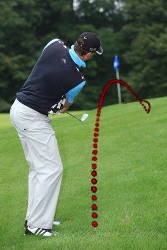
Feel in Golf
Golf is not just about the physical attributes like strength, flexibility, and technique. It also involves an intangible aspect called “feel.” Feel in golf refers to a golfer's ability to sense and control the subtle nuances of each shot – from the clubhead striking the ball to the distance, trajectory, and spin.
- Golf Club Connection: Feel begins with the connection between the golfer and the golf club. It is about understanding and experiencing the feedback the club provides during each swing. Through feel, a golfer can sense the weight and balance of the club, the timing of the release, and the impact with the ball.
- Shot Shaping: Feel plays a crucial role in shot shaping. It enables a golfer to control the flight of the ball and make it move left or right as desired. With a proper feel, a golfer can adjust the clubface angle, swing path, and body position to manipulate the ball flight and hit a draw or fade.
- Distance Control: One of the key aspects of feel is distance control. It involves understanding the relationship between swing speed, club selection, and the distance the ball will travel. Feel allows a golfer to develop a sense of touch, both for short shots around the greens and longer shots from the fairway.
- Putting: In putting, feel becomes even more crucial. The ability to gauge the speed, slope, and grain of the green is essential for sinking putts. Feel helps golfers judge the necessary force and read the subtle breaks, ultimately leading to successful putts.
- Adapting to Conditions: Feel also assists golfers in adapting to different course conditions. By sensing the firmness or softness of the ground, the wind direction and intensity, and the moisture level, golfers can adjust their shots accordingly. Feel allows golfers to make decisions on shot selection and execute them with confidence.
Developing a good feel in golf requires practice, experience, and a high level of self-awareness. Some tips to improve your feel:
- Practice Sensory Awareness: Pay attention to the sensations in your hands, body, and club during each swing. Focus on the feedback and try to develop a deeper understanding of how different swings produce different results.
- Experiment with Grip Pressure: Play around with the grip pressure to find the right balance between control and tension. Too tight of a grip can restrict feel, while too loose can lead to a lack of control. Find what works best for you.
- Visualize Shots: Before each shot, visualize the desired flight and outcome. This mental imagery helps to internalize the feel you want to achieve. Imagine the ball's trajectory, the sound of the strike, and the satisfaction of a well-executed shot.
- Learn from Experience: Pay attention to your shots and learn from your mistakes and successes. Analyze what felt right and what didn't. Over time, you will develop a more intuitive feel for your game.
Remember, feel is an essential but often overlooked aspect of golf. It elevates a golfer's game by allowing them to adapt, make informed decisions, and possess a heightened sense of touch on the course. With practice and focus, you can improve your feel and take your golfing skills to the next level.





